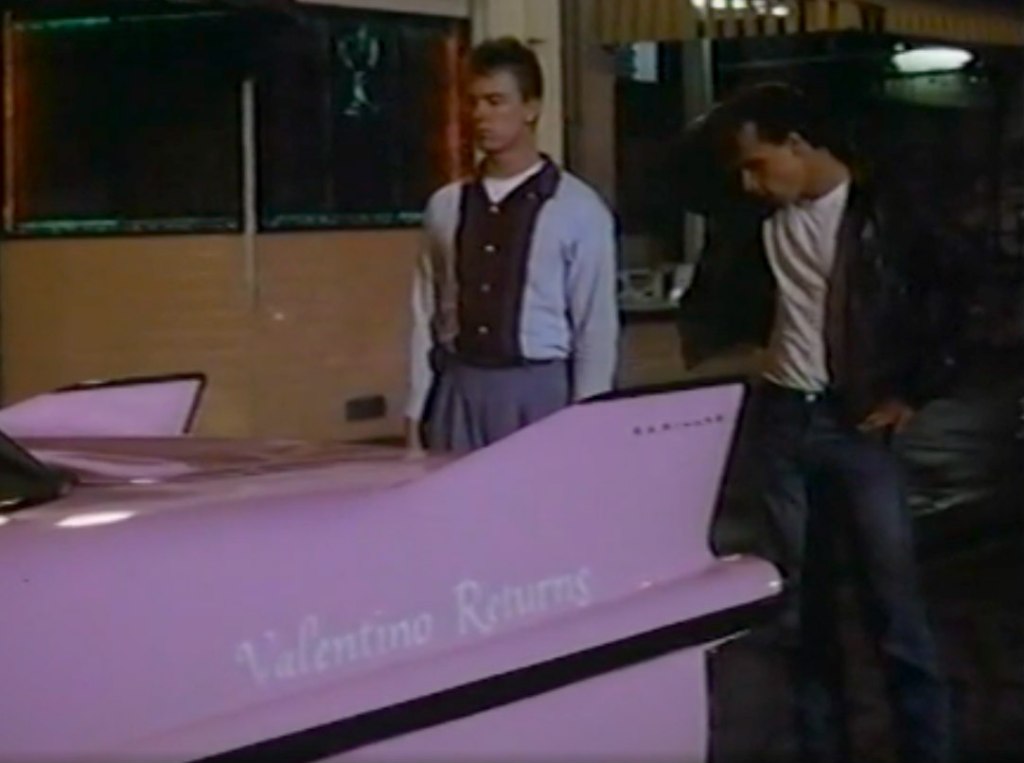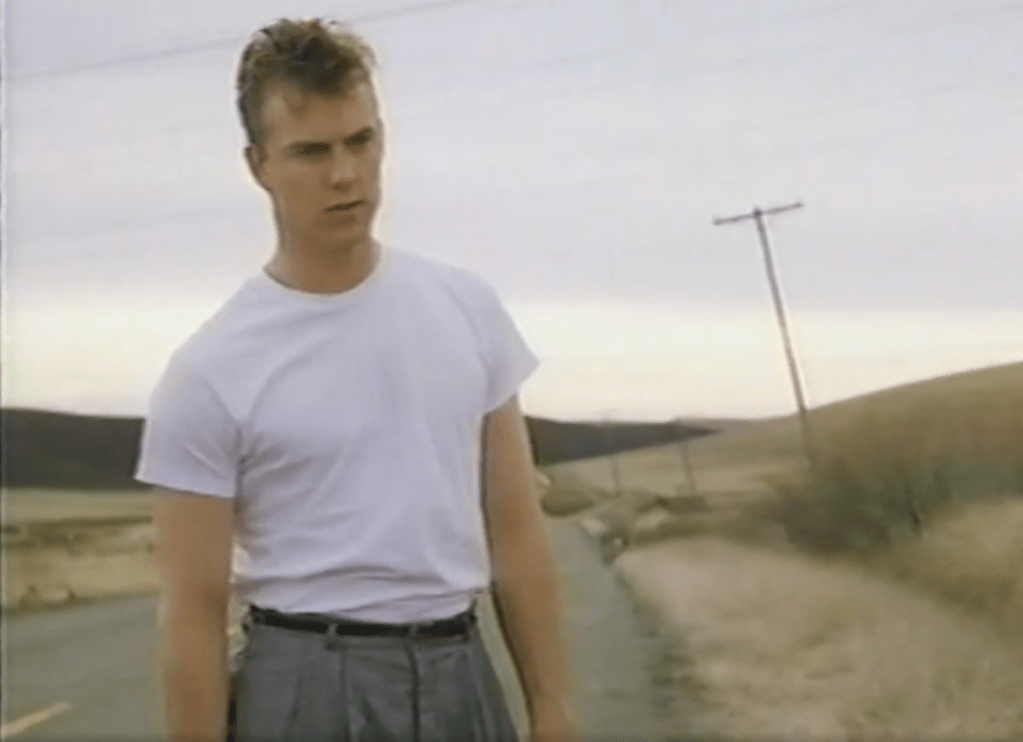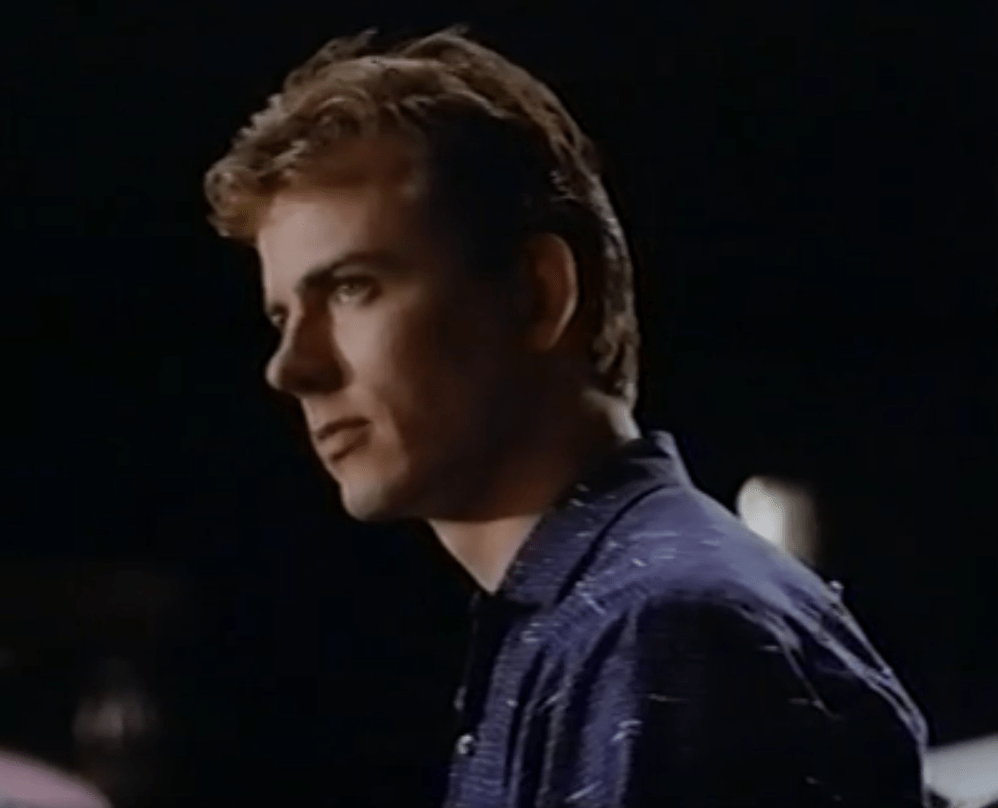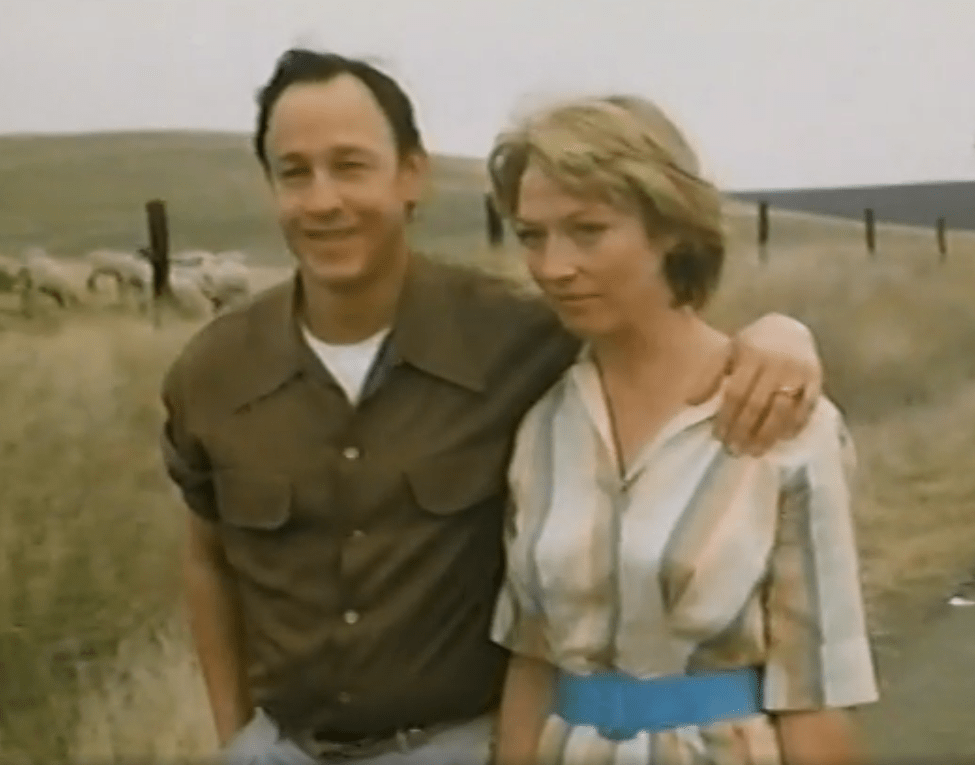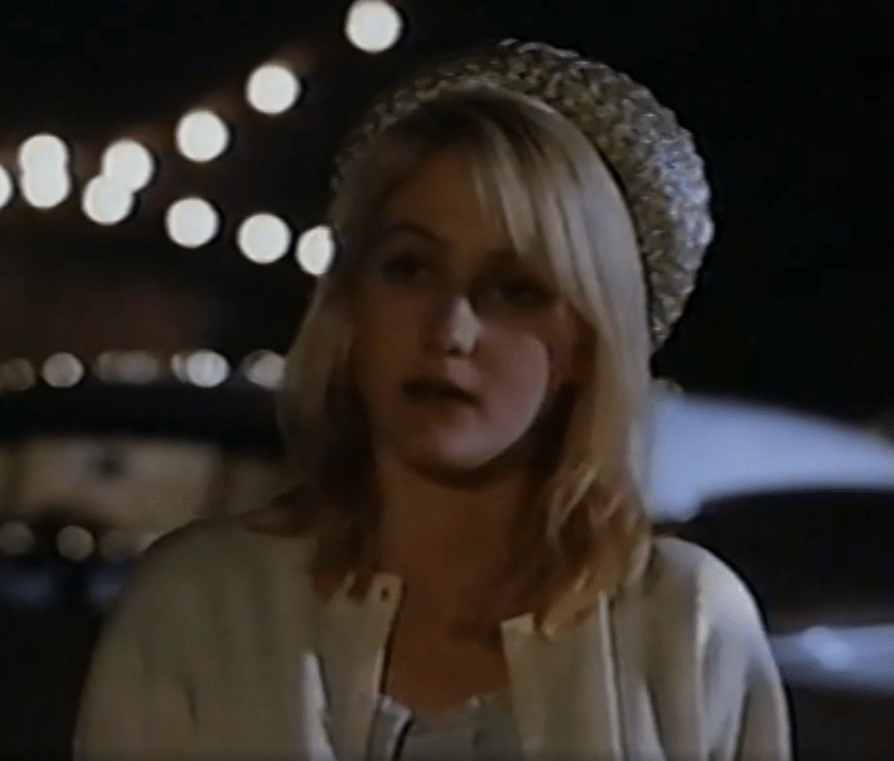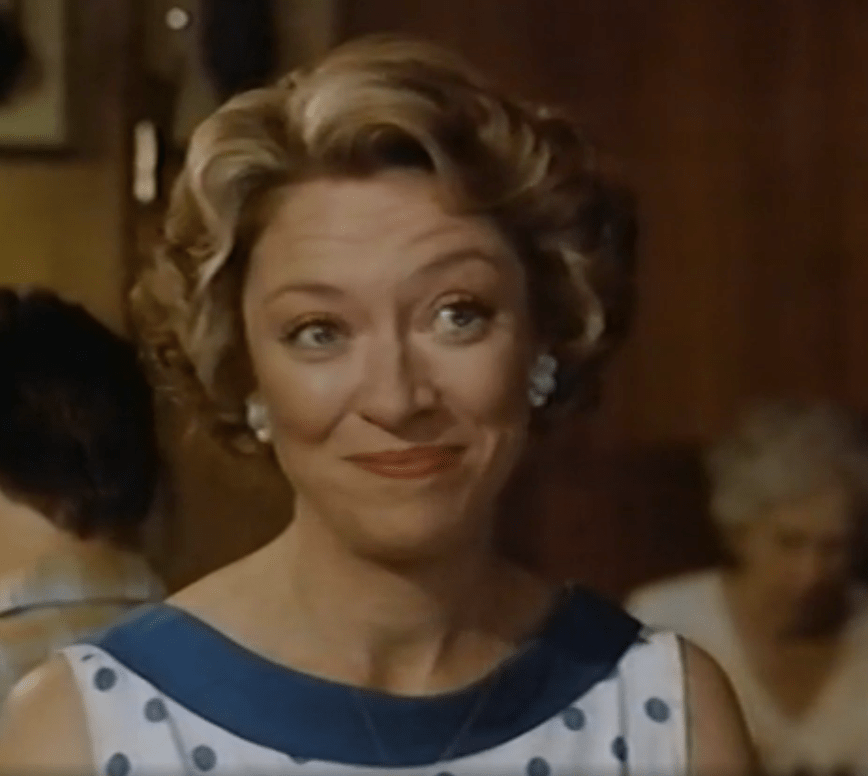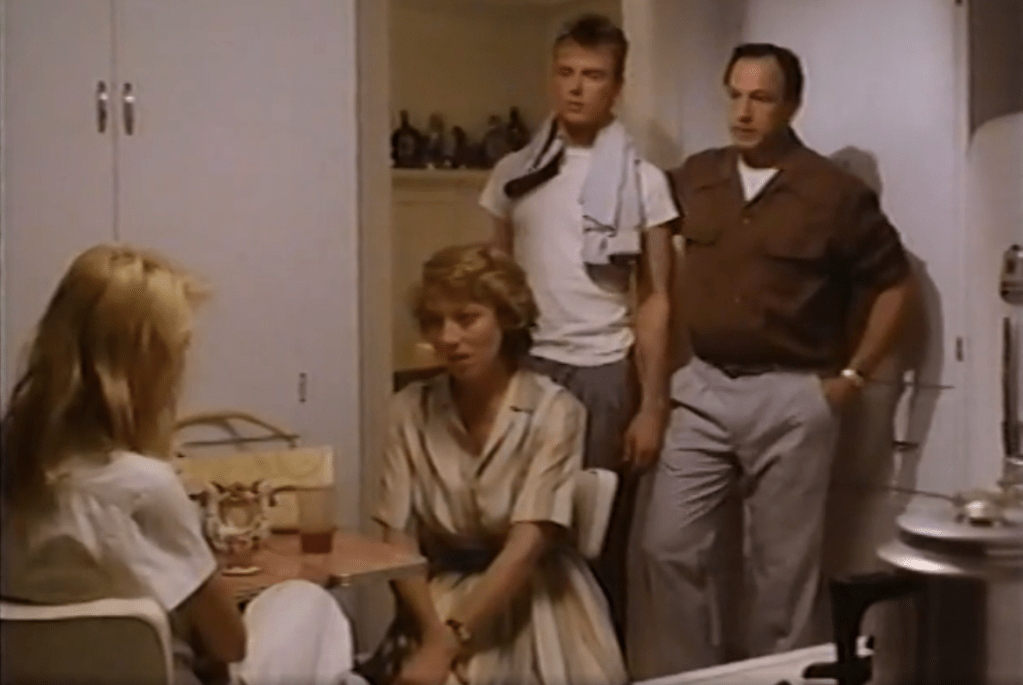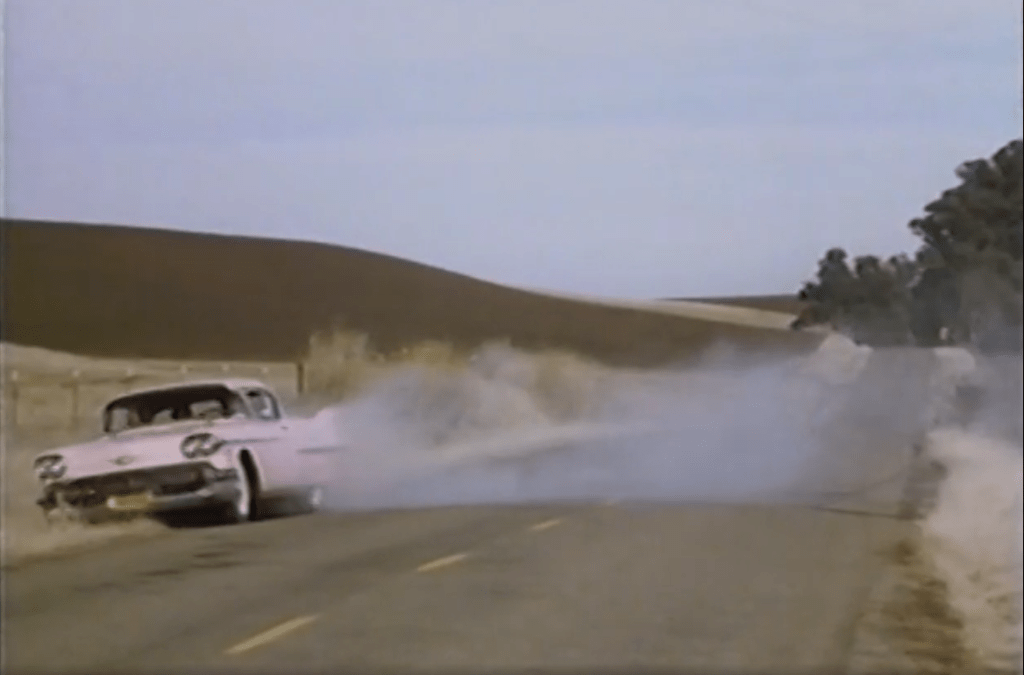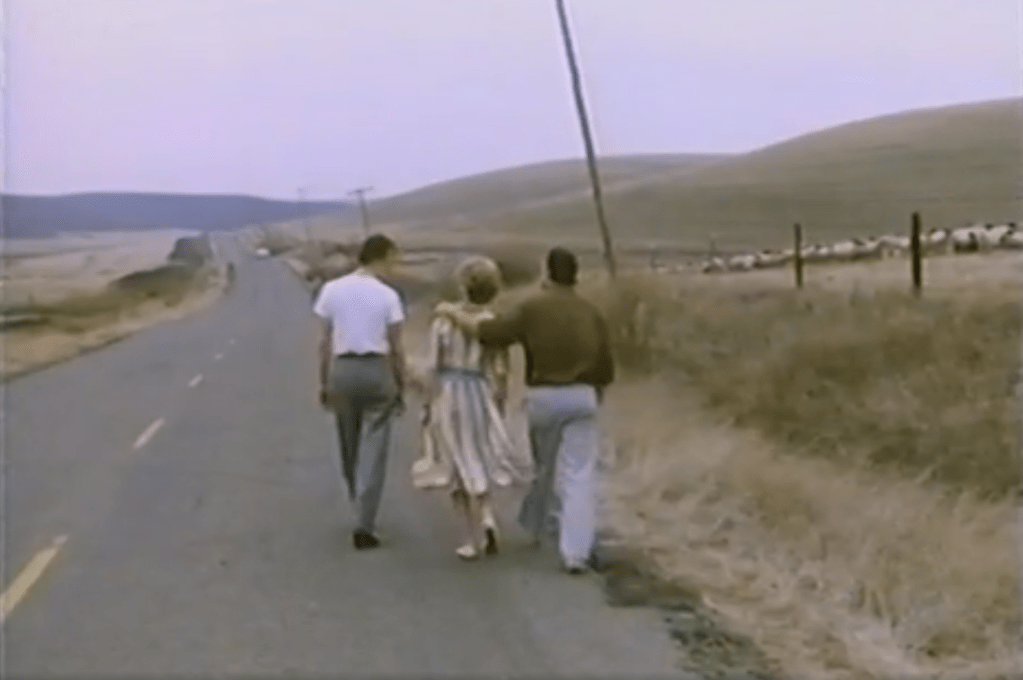Valentino Returns (1989)
Barry Tubb, Frederic Forrest, Veronica Cartwright, Jenny Wright and Miguel Ferrer
Director – Peter Hoffman
From Skouras Pictures/OWL Productions
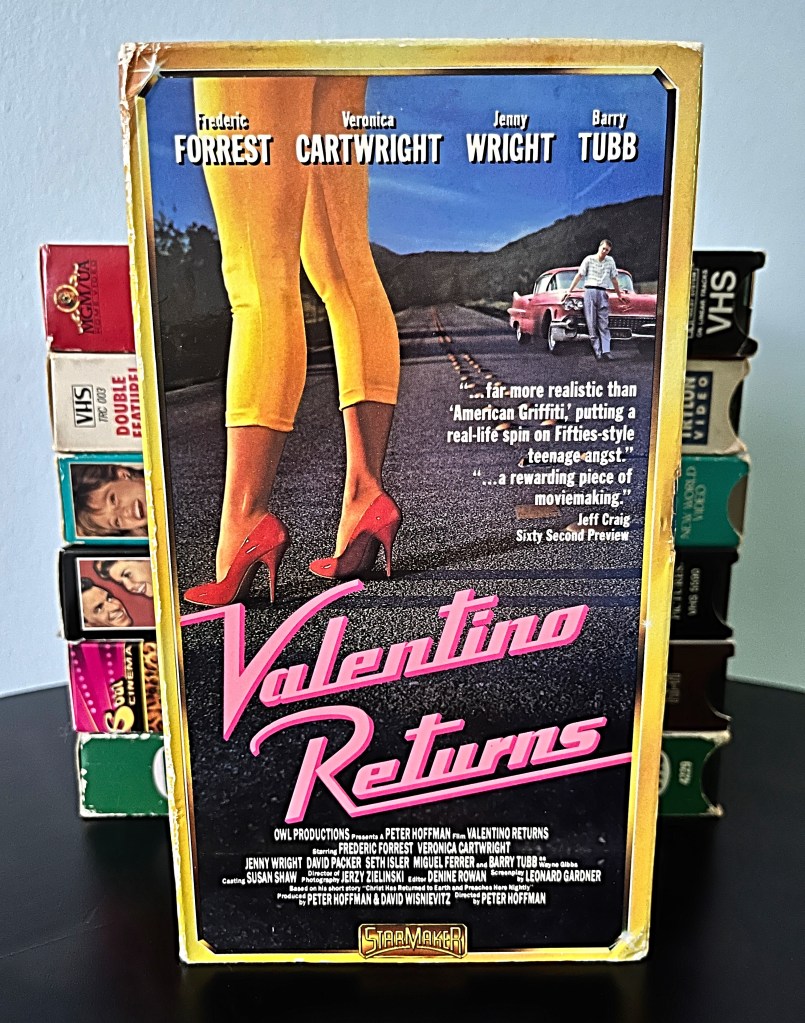
In the town of Tracy in 1950s rural California, Wayne Gibbs (Tubb) is a levelheaded, hard working young man who is ready to treat himself. He saunters in to a local car dealership and buys himself a new car. And not just any car – a brand new, pink Cadillac. Wayne immediately has his new rail christened, the name printed on the rear, driver side quarter panel – Valentino Returns. At a barn dance, he meets Sylvia (Wright) and the two hit it off. They make a future date but Wayne wonders when he sees Sylvia and a guy in the back seat of a car as it drives away.
Wayne shakes it off and takes his new rail to show his folks. Mom and Dad are going through a rough patch. His frustrated mother, Pat (Cartwright) is fed up with irresponsible Sonny (Forrest), known around town as an erstwhile lounge singer, loafer and philanderer. Eventually, Pat bolts which, of course, throws Sonny into a panic. But chances of reconciliation take a hit when Sonny gets in a wreck with a woman he was “just” giving a lift home.
When next Wayne sees Sylvia, he gives her static for leading him on but she insists she really likes him. The two of them finally have their date and it goes well despite getting hassled by some local boys. Adding to Wayne’s trouble, he and his buddy, Harry (Seth Isler), make a run to Stockton where they get picked up for solicitation, run afoul of some bikers and Wayne throws a rod on the Caddy while racing their leader (Ferrer). All the while, Wayne is troubled to see his parents’ marriage disintegrating.
Taking Sylvia home late after a date, the two kids are attacked by Sylvia’s bonkers father (Macon McCalman) and they flee to Wayne’s house. There, Wayne’s folks console the two lovers and take Sylvia home as a group. Things don’t go well but Wayne and his family form a bond that may just be enough to traverse all obstacles.
It thrills me to have films like this in my life. Movies I stumble on that seemingly no one else has seen and ones that I cherish as they travel with me from my teenage years and on into middle age. Valentino Returns I may have discovered on the late show as a teen. I taped it off TV and watched it many times over the years. Then one day only recently I found it on VHS at a garage sale and was happy to scoop it up; I still remember the house. That’s my tape pictured above and I’ll be hanging on to it as it is a rare film in that it has never been released on DVD.
Writer Leonard Gardner was born in Stockton on my birthday in 1933 – he’s apparently still among us as of this writing. In 1969, he published his only novel, Fat City. It’s a book that has grown in stature over the years, helped in no small part by the highly-rated 1972 film version directed by John Huston. His short story, “Jesus Christ Has Returned to Earth and Appears Here Nightly”, serves as the basis for his screenplay for our film and Leonard even appears in Valentino Returns as Gibbs family friend, Lyle. Later, Gardner would work for a few years on TV’s NYPD Blue as a writer and/or producer.
Where did director Peter Hoffman come from and where did he go? Not a clue. He was not only director and producer here but he was also the money, financing this his only credit before heading back to…wherever he came from. This one-off certainly adds to the “deep cut” cred of this film. Much the same can be said for our star.
Barry Tubb is a Texas boy and a real cowboy-type like his character, Wayne. Born in Snyder in 1963, he was a high school bull riding champ before moving into acting. While he never received much recognition, he did show up in a few notable properties. He found regular work in Steven Bochco TV shows Bay City Blues and Hill Street Blues, a recurring role in Lonesome Dove and its sequel and he appeared as Wolfman in Top Gun; in fact, when the blockbuster sequel was released in 2022, Tubb – for some reason – sued Paramount for using his image without permission.
The cast boasts no real stars but the parents are portrayed by prolific stalwarts of film and television. Another Texan, Frederic Forrest (1936-2023) is best remembered today for his work in the films of Francis Ford Coppola, most notably as Chef who swears he will never get out of the boat again in Apocalypse Now (1979) but also in The Conversation, One From the Heart and Tucker: A Man and His Dream. He also received an Oscar and a Golden Globe nomination for The Rose also from ’79. Born in Bristol, England, Veronica Cartwright (born 1949) I always think of as Beaver’s little girl friend, Violet Rutherford – which makes it odd seeing her undraped in Valentino Returns. Cartwright also appears in some significant films like The Children’s Hour (1961), The Birds (1963), Alien (1979) and The Right Stuff (1983).
You may not know it but Jenny Wright also warrants some discussion. Here she takes a star turn but I had always known her from her smaller role in one of my all-time faves, 1985’s St. Elmo’s Fire as Felicia, the mother of Billy Hicks’ (Rob Lowe) baby. At 16, Jen modelled for Salvador Dalí. She then studied at the Lee Strasberg Theatre Institute, appeared on stage with Kevin Bacon and on TV with Mickey Rourke before featuring as an abused groupie in Pink Floyd – The Wall (1982). With her appearance in St. Elmo’s Fire, Wright was lumped in with the Brat Pack, something she didn’t care for. Subsequently, she chose to appear in Near Dark, a 1987 neo-Western horror film that was Kathryn Bigelow’s directorial debut. For this, Jenny won a Best Actress award from the Paris International Fantastic & Sci-Fi Film Festival. But she wasn’t able to sustain a career despite roles in Young Guns II and The Lawnmower Man. By the mid-90s, Jenny had dropped off the face; and not just in film but from public life. I put Jenny Wright with Lori Petty; cuties with a couple of notable appearances but who’s quirkiness kept them from stardom.
And quickly, the late Miguel Ferrer was the first child born to José Ferrer and Rosemary Clooney. Miguel maintained visibility through the years with turns in Star Trek III: The Search for Spock and RoboCop before scoring steady work on TV’s Crossing Jordan. But dig this; in 1975, while only 20 years old and before his acting career began, Miguel played drums on the only solo album from Keith Moon of The Who, Two Sides of the Moon. While this brief cameo may not seem like a big deal, consider that Ferrer played drums on an album by one of rock’s greatest drummers, on an album that also featured (get ready) Ringo Starr, Ricky Nelson, Harry Nilsson, Spencer Davis, Joe Walsh, Dick Dale, David Foster and David Bowie among others. Cool little nugget for you there.
So, the cast is serviceable, even good but there are other – some less tangible – appealing things about Valentino Returns. Probably first and foremost is the soundtrack. At the beginning there’s a nice smash cut to the opening credits and “Blue Monday” by Fats Domino and it’s well used, too, as Wayne is shown working hard. Throughout the film you’ll hear many favourites like “Good Golly, Miss Molly”, “Earth Angel”, “All I Have to Do is Dream”, “Little Star” and “Maybe”. Valentino Returns marked for me the first time hearing “For Your Precious Love”. This 1958 gem by Jerry Butler and the Impressions is used significantly at the end of the film; the lyrics may not fit the action but the ambience of this gentle song adds a poignancy to the end of the screen story.
And there are other story elements that come off well making this film enjoyable. And this is perhaps surprising considering the neophyte director and screenwriter and the calibre of this cast. Most importantly may be the film’s avoidance of cliché when depicting the Fifties. There are no flashy outfits or too-typical 50s living rooms. The settings look authentic; successful in depicting rural California in the 1950s. And veterans Forrest and Cartwright do a good job in showing the difficulty between married folks at a trying time of their lives. Forrest plays the heel well and Cartwright nails her character’s exasperation. Sadly, religion is portrayed poorly in the film. It’s the old cliché of the super-strict parents forcing their kids into the straitjacket through guilt and threats of damnation. What is even more sad, I guess, is the fact that this maybe is a real depiction of how many people view religion, then and now. It’s my opinion that relationship with Jesus is the polar opposite of “religion”, particularly the kind seen here.
You gotta like Wayne, though. He has an indomitable spirit and he is an individual; notice he doesn’t wear a “gang” jacket like his two friends do. He is resourceful and hard working, holding down two jobs to pay for his dream ride. He is sensible enough to baby his car’s new engine until he gets some mileage on it but he also scores points for rising to the challenge put forth by the biker at the stoplight. Sylvia sees it in him, too; “you’re sorta what I been lookin’ for”, she says to Wayne. Nice line. While he’s no Brando, Gibbs can show that Wayne is worried about his parents and disappointed in his dad and the charms of this family’s chemistry are evident. Watch them as they take Sylvia into their kitchen when she is in a jam. The family seems to bond as they take her under their wing and return her to her folks and Wayne’s parents square off against Sylvia’s admirably. There is something about the last moments of this film. The family has come to an impasse. Pat and Sonny are not home free yet and there are definitely things to work out but they are walking together at the end and viewers can feel like they spy hope. Wayne is forced to leave his car by the side of the road but his determination can clearly be seen in the set of his jaw and his steely gaze. Notice that he smiles and much is said in that smile. One feels that he is equipped to work this out and navigate anything else life may bring.
It’s a substantial ending to what could be considered a lightweight film. The cast is pretty good, the whole look of the picture is right and so is the entire tone. This is maybe not a major unearthing of a film that desperately warrants reappraisal but this is a nice little gem that is hard to find (click here, maybe). And this one really means something to me.
